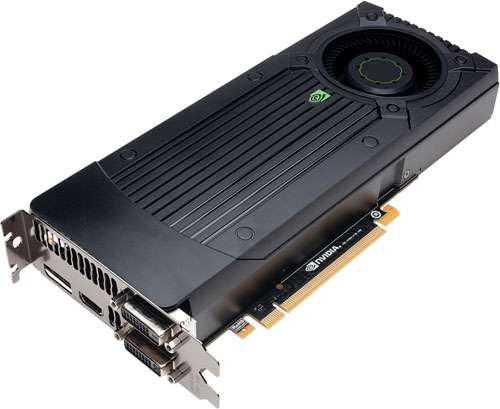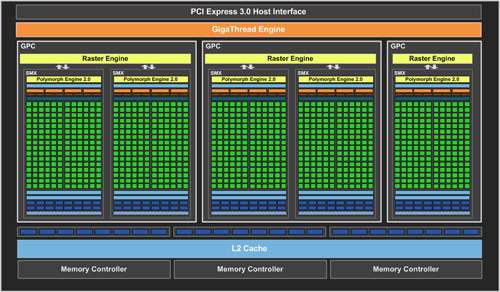Just a month ago, NVIDIA released its GeForce GTX 660 Ti, which was received to rather critical acclaim. Specs-wise, the card isn't too far off from the GTX 670 which costs $100 more. But at $300, the card wasn't exactly "affordable" by all standards. NVIDIA knew it had a duty to finally deliver a mainstream Kepler part as close to $200 as possible, and that's resulted in the $229 non-Ti GTX 660.
The GTX 660 is equipped with 960 cores, vs. 1344 with the Ti. That comparison alone can give us an idea of what to expect here. Well, it would be easy if NVIDIA, in its usual way, didn't give the core clock a nice boost on the non-Ti edition. Lesser cores, but +65MHz to the clock. An interesting move, and not one that anyone will complain about.
Memory density and general architecture layout remain similar between the two cards, although while the 660 Ti is based on the GK104 chip, this non-Ti version uses GK106. Whereas typical GPCs, or Graphics Processing Cluster, have two SMX units per, GK106 splits one right down the middle, as the following diagram shows:
This is an odd design, but won't result in some sort of bottleneck as all SMX modules interface with their respective raster engine rather than each other.
Though this non-Ti edition of the GTX 660 drops the core count quite significantly, its increase in core frequency negates some of the additional power savings we would have seen. For that reason, the non-Ti is rated at 140W, vs. 150W of the Ti.
Alongside the GTX 660, NVIDIA has also launched the GTX 650, although availability at this point is nil. Despite being briefed on both of these cards at the same time, I haven't found a single review online of the GTX 650, so it's to be assumed that NVIDIA isn't rushing that product out too fast, and if I had to guess, it's a card that exists only to finish off the sequential numbering system. Laugh all you want, but imagine the table above without the GTX 650. That'd look rather odd, wouldn't it?
That aside, for NVIDIA to call it the GTX 650 is a bit of an insult to the GTX name. In no possible way does this GPU deserve it - GTX has traditionally represented cards that could more than handle games being run with lots of detail and at current resolutions. "GTX" is certainly suitable for the 660, but how did NVIDIA deem the 650 worthy when it slots just barely in front of the $100 GT 640? Maybe next we'll see Porsche release a 4 cylinder 911 Turbo S.
Rant side, the vendor to provide us with a GTX 660 sample is GIGABYTE. Unfortunately, it's an "OC Version", which means we are unable to deliver baseline GTX 660 results (I am not keen on forcing turbo adjustments). Making matters a bit worse, the OC isn't that minor. Memory remains the same, but the core gets +73MHz tacked on. An OC like this is great for consumers, but tough on reviewers who'd like to compare GPUs fairly.
With all of the launches NVIDIA's done in the past couple of months for Kepler, it was difficult to explore GTX 660 with anything more than minimal enthusiasm. However, from what we've seen throughout all of our testing, the GTX 660 is actually quite an impressive card, and possibly one of the most important to NVIDIA's entire 600 series line-up.
The reason for that boils down to the affordable price-point, and the performance it delivers. A $229 card that can handle a graphically gorgeous game like Battlefield 3 at Ultra detail at 1080p? Do I really need to explain why that's awesome?
Unfortunately, we didn't have a GPU that was directly comparable to this one, so there's really no apples to apples comparison. AMD's Radeon HD 7850 comes closest, at about $200. In that match-up, we saw the GTX 660 consistently perform better than the HD 7850, with the lowest gains being seen in the heavily AMD-favored DiRT: Showdown. Performance increases of 10-20% were not uncommon. In the also AMD-favored SHOGUN 2, the GTX 660 averaged 50% faster.
The GTX 660 is equipped with 960 cores, vs. 1344 with the Ti. That comparison alone can give us an idea of what to expect here. Well, it would be easy if NVIDIA, in its usual way, didn't give the core clock a nice boost on the non-Ti edition. Lesser cores, but +65MHz to the clock. An interesting move, and not one that anyone will complain about.
Memory density and general architecture layout remain similar between the two cards, although while the 660 Ti is based on the GK104 chip, this non-Ti version uses GK106. Whereas typical GPCs, or Graphics Processing Cluster, have two SMX units per, GK106 splits one right down the middle, as the following diagram shows:
This is an odd design, but won't result in some sort of bottleneck as all SMX modules interface with their respective raster engine rather than each other.
Though this non-Ti edition of the GTX 660 drops the core count quite significantly, its increase in core frequency negates some of the additional power savings we would have seen. For that reason, the non-Ti is rated at 140W, vs. 150W of the Ti.
| Cores | Core MHz | Memory | Mem MHz | Mem Bus | TDP | |
| GeForce GTX 690 | 3072 | 915 | 2x 2048MB | 6008 | 256-bit | 300W |
| GeForce GTX 680 | 1536 | 1006 | 2048MB | 6008 | 256-bit | 195W |
| GeForce GTX 670 | 1344 | 915 | 2048MB | 6008 | 256-bit | 170W |
| GeForce GTX 660 Ti | 1344 | 915 | 2048MB | 6008 | 192-bit | 150W |
| GeForce GTX 660 | 960 | 980 | 2048MB | 6000 | 192-bit | 140W |
| GeForce GTX 650 | 384 | 1058 | 1024MB | 5000 | 128-bit | 64W |
| GeForce GT 640 | 384 | 900 | 2048MB | 5000 | 128-bit | 65W |
| GeForce GT 630 | 96 | 810 | 1024MB | 3200 | 128-bit | 65W |
| GeForce GT 620 | 96 | 700 | 1024MB | 1800 | 64-bit | 49W |
| GeForce GT 610 | 48 | 810 | 1024MB | 1800 | 64-bit | 29W |
That aside, for NVIDIA to call it the GTX 650 is a bit of an insult to the GTX name. In no possible way does this GPU deserve it - GTX has traditionally represented cards that could more than handle games being run with lots of detail and at current resolutions. "GTX" is certainly suitable for the 660, but how did NVIDIA deem the 650 worthy when it slots just barely in front of the $100 GT 640? Maybe next we'll see Porsche release a 4 cylinder 911 Turbo S.
Rant side, the vendor to provide us with a GTX 660 sample is GIGABYTE. Unfortunately, it's an "OC Version", which means we are unable to deliver baseline GTX 660 results (I am not keen on forcing turbo adjustments). Making matters a bit worse, the OC isn't that minor. Memory remains the same, but the core gets +73MHz tacked on. An OC like this is great for consumers, but tough on reviewers who'd like to compare GPUs fairly.
With all of the launches NVIDIA's done in the past couple of months for Kepler, it was difficult to explore GTX 660 with anything more than minimal enthusiasm. However, from what we've seen throughout all of our testing, the GTX 660 is actually quite an impressive card, and possibly one of the most important to NVIDIA's entire 600 series line-up.
The reason for that boils down to the affordable price-point, and the performance it delivers. A $229 card that can handle a graphically gorgeous game like Battlefield 3 at Ultra detail at 1080p? Do I really need to explain why that's awesome?
Unfortunately, we didn't have a GPU that was directly comparable to this one, so there's really no apples to apples comparison. AMD's Radeon HD 7850 comes closest, at about $200. In that match-up, we saw the GTX 660 consistently perform better than the HD 7850, with the lowest gains being seen in the heavily AMD-favored DiRT: Showdown. Performance increases of 10-20% were not uncommon. In the also AMD-favored SHOGUN 2, the GTX 660 averaged 50% faster.


No comments:
Post a Comment